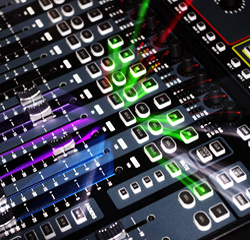
One of the coolest features of Yamaha Commercial Audio QL Series consoles (and soon available to CL Series console users in the just-announced Version 3.0 update available in early 2015—more here) is the Dan Dugan 16-channel automatic microphone mixer that is included onboard in the software.
While Dugan auto-mixing has been available to Yamaha digital console users in a MY16 option card format, having the capability built into the software frees up an expansion card slot for other duties. Once inserted into the EQ rack, the auto-mixer detects active live mics and makes fast, transparent cross-fades without the distracting sonic artifacts common to noise gates. It lets us easily manage 16 open mics without continually riding individual faders, perfect for larger speech and meeting events.
Another interesting feature in V3.0 is the addition of a real time analyzer (RTA) to support room tuning and other operations. The frequency spectrum of cued channels can be shown in the new RTA display as well as in the PEQ or GEQ display to provide visual feedback while adjusting EQ.
PreSonus consistently delivers clever, highly useful designs, with the new StudioLive RM Series (more here) keeping with that mantra. These rack-mounted mixers use an operator-supplied surface for operation—no control surface—so they can be mounted in a rack and controlled via software for Mac, PC and iPad. Personal monitoring of up to 16 separate monitor mixes is also easily accomplished via the QMix-AI app for iPhone.
In addition, the StudioLive RM Series closely integrates recording capabilities. Capture recording software for PC and Mac allows instant setup and recording directly from the mixer with no configuration. Besides recording all channels, Capture also allows recording a stereo track from the main outputs, subgroup outs, aux sends, solo bus, talkback mic, aux inputs, and internal FX sends or returns. Talk about a lot of options for 2-track recording…
The Avid SL3 turned a lot of heads when it was introduced, taking a totally modular approach. The ultra-compact SL3, which runs VENUE software, consists of the control surface, E3 engine and one or more Stage 16 remote I/O boxes. Now, the new VENUE SL3-X (more here) furthers the ability to mix and record live shows with efficiency, as well as to create new material or mix down live recordings for commercial purposes. Combined with Pro Tools software on the Avid MediaCentral Platform, it’s straight-up a powerful integrated direction.
Of course, the use of plug-ins for live applications was also something that started small and now proliferates. Avid’s been on this from the beginning, and now VENUE software runs a mind-boggling array of AAX plug-ins from both Avid and third-party developers, providing us with an almost unlimited number of processing options.
Soundcraft has done a fine job of making mixing in the digital age an easier task, and in my view, one of the key aspects is attention to providing intuitive control surface interfaces. In fact, it’s likely induced others to place more focus on this as well. The recently released Vi3000, for example, is outfitted with four large Vistonics II touchscreens with 3-D graphics.
Built into each color Vistonics screen are 16 rotary encoders, so where you look is where you control. Functions are color-coded and change according to the selected mode, and one touch of the screen is all it takes. In addition, FaderGlow helps reduce the confusion caused by assignable faders by allowing the fader tracks to illuminate in various colors, depending on fader assignment.
The Vi3000 also accommodates the new Soundcraft Realtime Rack, a hardware/software unit designed in collaboration with plug-in manufacturer Universal Audio that provides access to 74 industry-standard UAD plug-ins. The scalable, low-latency processing system offers dual-redundant internal power supplies to help ensure that audio signals keep running even in the event of a power supply failure.
